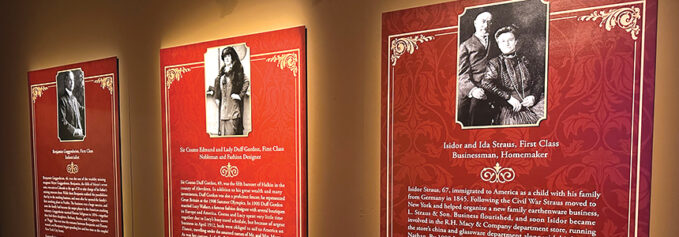
By Melissa Donovan
We live in a world that relies heavily on digital videos and projections, or even tricks of light. However, the power of print is still integral to messaging. This pertains to traditional promotional marketing yes, but even art or exhibitions meant for entertainment or experience leverage print. Large format graphics convey messaging in meaningful ways. Combined with digital signage, the multi-media experience is powerful.
Above: To complement the physical objects on display at the TITANIC: The Artifact Exhibition in Boston, MA, accurate, clear photography is key.
World-Class Exhibition
A tangible example of this is TITANIC: The Artifact Exhibition. E/M Group, based out of Peachtree Corners, GA, is an expert at creating world-class exhibitions that utilize themed settings, theatrical innovations, and state-of-the-art media. The company curates two permanent Titanic-themed exhibitions in Las Vegas, NV and Orlando, FL as well as five touring exhibitions.
One of the tours made its way to Boston, MA in November 2024. Held at The Saunders Castle at Park Plaza, the 15,000 square foot exhibition features replica interior rooms of the RMS Titanic, a full-scale renovation of the Grand Staircase, artifacts recovered from the site in the North Atlantic, and quotes from passengers and crew.
E/M Group’s affiliate RMS Titanic, Inc. (RMST) serves as the exclusive steward of the RMS Titanic. Dedicated to preserving the legacy of the ship, wreckage site, and passengers and crew, RMST has conduced eight research expeditions since 1987, recovering more than 5,500 artifacts, which are part of the TITANIC: The Artifact Exhibition.
History Respected
It’s a huge undertaking to respectfully portray the histories of those part of the inaugural RMS Titanic voyage as well display artifacts from the ship’s wreckage. Plates, cups, and utensils from first class dining rooms; chamber pots from second class; and a pair of shoes are just some of what is on display.
To complement the physical objects, accurate, clear photography is key to a successful historical exhibit. “Most of the images we have are low resolution, B&W or sepia, but we use technology to get them up to par. We talk with the printer and let them know our specifications whether its 100 or 300 dpi depending on the final size of the print,” explains Andrew Agyemang, print production coordinator, E/M Group.
Cut vinyl is used throughout the exhibit site. Direct quotes from various passengers as well as notable crew members like Captain Edward J. Smith are found.
“We work hard to review images and text, double checking if this is the actual picture of a lifeboat from the RMS Titanic, for example. The great thing is, we have these didactics and labels, we use the same wording but we might need it translated, so we work with third parties to make sure it is translated correctly and maintains its integrity,” shares Tomasina Ray, director of collections, E/M Group/president, RMS Titanic, Inc.
Agyemang works directly with the print service provider (PSP) responsible for the majority of the digitally printed graphics and cut vinyl seen throughout the inside of the exhibition. Parallax Digital Studios of Kennesaw, GA has been the PSP of choice for TITANIC: The Artifact Exhibition since 2016.
Graphics are printed in the GA facility using EFI VUTEk h5 UV LED hybrid printers and then shipped to the various exhibit locations. According to Lee Clevenger, VP of operations, Parallax Digital, the EFI VUTEk h5 devices are ideal for jobs like this because of their reliability. Capable of handling multiple types of substrates, the output yielded is visually consistent whether it is flexible or rigid.
A traveling exhibition, the graphics need to withstand bumps and dings when shipped and handled between each location. “We look for durability as far as the graphic being able to hold up during the length of the install. Durability is important for traveling to the next location as well,” notes Agyemang.
Parallax Digital prints directly to KömaTex free-foam PVC sheets from Kömmerling. The media is not laminated, thanks to the EFI UltraClear Coat available on the EFI VUTEk h5 printer. Used for decorative applications as well as for a final protective coating, it prints inline, simultaneously with the image.
The final printed products are simple to wipe down in the field where attendees may touch the graphics when on display.
Replacing a graphic ruined during transport needs to be straightforward. “Because the exhibition is so plug and play, it’s easy to find consistency across the various materials, so if something becomes damaged we can find a replacement easily and reprint,” explains Ray.
When this happens, Agyemang and his team reach out to a PSP local to the exhibit location to re-do the graphic. In this instance, sometimes other rigid substrate materials are used like 3A Composites USA’s expanded PVC SINTRA board. Exterior graphics promoting the exhibition, like pole banners and flags, are usually created by local PSPs as well.
Bringing it All Together
E/M Group leverages large format graphics in meaningful ways, but it also complements static signage with digital to create a powerful multi-media experience. “We started to bring in video elements and projectors that add a little more color, but we want the photographs to remain true to the time period,” admits Ray.
The lighting crew focuses on illuminating each graphic so the final result is like a light box. “It makes them come off the walls. The walls disappear and the graphics really pop out,” continues Ray.
Speaking of the crew, setup takes a good amount of time. The Boston, MA location was a two week process that included hanging lighting, installing walls, putting down flooring, setting display cases and placing the artifacts in them, and then adding the graphics to the walls. Graphics are installed to walls using velcro, which allows for ease of removal.
While large format print is pivotal in an exhibition space, smaller format graphics also play a role. At TITANIC: The Artifact Exhibition they are used in a uniquely personal way. When attendees enter the exhibition space, they are presented with a 4×6-inch boarding pass. The front includes information about the White Star Line’s RMS Titanic, and the back presents a passenger biography.
MDJ & Associates of IL produces all of the boarding passes for the U.S. exhibitions. 160 cards are distributed per visiting time slot, 80 female and 80 male. “It gives a first person perspective of being on the RMS Titanic. You can identify a little closer with some of the objects,” explains Ray.
At the end of the exhibit, visitors can scan their boarding pass to find out if the passenger survived or perished. In the same room, a 100×96-inch digitally printed memorial wall lists the names of each deceased passenger, divided by first, second, and third class, as well as crew members.
Quality and Durability
E/M Group has decades of experience in creating powerful, multi-media exhibitions. Partnering with companies like Parallax Digital ensures the graphics’ quality respects the topic matter and signage remains intact. Ray hopes visitors “walk away and need a moment to digest it, but hopefully it triggers more questions.” TITANIC: The Artifact Exhibition in Boston, MA is open through February 2025.
Jan2025, DPS Magazine



